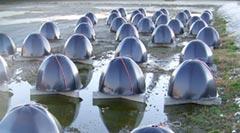 n-eating device that can clean up sewage just as effectively as multimillion-dollar treatment facilities.
n-eating device that can clean up sewage just as effectively as multimillion-dollar treatment facilities.Developed by researchers at the University of Utah, the sewage-eating device, called 'Poo-Gloos', use a thriving bacterial biofilm to consume pollutants from sewage lagoons.
It consists of a set of four progressively smaller, plastic domes nested within each other like Russian nesting dolls and filled with plastic packing to provide a large surface area for bacterial growth. Rings of bubble-release tubes sit at the base of every Poo-Gloo and bubble air up through the cavities between domes.
The air exits a hole in the top of each dome. As air moves through the dome, it draws water from the bottom of the lagoon up through the dome and out the top.
As part of the study, researchers installed about dozens of Poo-Gloo devices at a sewage lagoon in Plain City, Utah.
"The results of this study show that it is possible to save communities with existing lagoon systems hundreds of thousands, if not millions of dollars, by retrofitting their existing wastewater treatment facilities with Poo-Gloos," said Fred Jaeger, chief executive officer of Wastewater Compliance Systems Inc, which sells the device under the name Bio-Dome.
The device was actually developed by a team led by WCS's chief technology officer Kraig Johnson when he worked as a professor of civil and environmental engineering at the University of Utah.
It
The device provides a large surface area on which bacteria can grow, providing the microbes with air and a dark environment so they consume wastewater pollutants continuously with minimal competition from algae.
The study found the devices consistently achieved high levels of treatment that were affected only slightly by changing water temperatures and aeration levels.
"The removal rates we saw during the pilot test are comparable to removal rates from a rotating biological contactor, which is a commonly used device in mechanical treatment facilities," Johnson said.
"We couldn't be happier with the performance of the Poo-Gloos."
According to Johnson, who will present their research during the Water Environment Federation's Impaired Water Symposium to be held in Miami on Thursday, there may be uses for the Poo-Gloos beyond municipal wastewater treatment.
He said: "The bugs will adapt to consume whatever is available. In addition. . . ,we've also seen great results in the consumption of other significant pollutants. "Poo-Gloos, or Bio-Domes as we call them, have a lot of potential, and we've only just scratched the surface."









 © 2025
© 2025